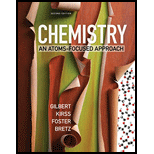
To write:
The names of coordination compounds of chromium(III) given in the problem 23.20.
Answer to Problem 23.22QA
Solution:
a) Hexaaquachromium(III) chloride
b) Pentaaquachlorochromium(III) chloride
c) Tetraaquadichlorochromium(III) chloride
Explanation of Solution
Based on the information given in Problem 23.20, the formulas of the chromium(III) coordination compounds are:
a)
b)
c)
When writing the name of the coordination compound, if the counter ion of the complex ion is a cation, the cation’s name goes first followed by the name of the anionic complex ion.
If the counter ion of the complex ion is an anion the name of the cationic complex ion goes first followed by the name of the anion.
Taking an inventory of the ligands and counter ions in all the three compounds:
| Compound | Ligand | ||||
| Counter ion | Formula | Name | Number | Prefix | |
| aqua | Hexa- | ||||
| aqua | Penta- | ||||
| chloro | 1 | - | |||
| aqua | Tetra- | ||||
| chloro | 2 | Di- | |||
The oxidation state of the central metal ion is calculated by setting the sum of the charges on all the ions in the compound equal to zero.
a) Oxidation state of central metal ion:
Oxidation state of Cr is
The complex ion is the cation in this compound. We begin by naming the ligand directly attached to the metal ion: aqua. The number of ligands is indicated by the prefix as hexaaqua. The name of the metal indicating its oxidation state with a Roman numeral is written as: hexaaquachromium(III). The name of the counter ion is chloride.
So, the full name of compound is hexaaquachromium(III) chloride.
b) Oxidation state of central metal ion:
Oxidation state of Cr is
The complex ion is the cation in this compound. We begin by naming the ligand directly attached to the metal ion in alphabetical order: aqua and chloro. The number of ligands is indicated by the prefix as pentaaqua and chloro. The name of the metal indicating its oxidation state with a Roman numeral is written as: pentaaquachlorochromium(III). The name of the counter ion is chloride.
So, the full name of compound is pentaaquachlorochromium(III) chloride.
c) Oxidation state of central metal ion:
Oxidation state of Cr is
The complex ion is the cation in this compound. We begin by naming the ligand directly attached to the metal ion in alphabetical order: aqua and chloro. The number of ligands is indicated by the prefix as tetraaqua and dichloro. The name of the metal indicating its oxidation state with a Roman numeral is written as: tetraaquadichlorochromium(III). The name of the counter ion is chloride.
So, the full name of compound is tetraaquadichlorochromium(III) chloride.
Conclusion:
The names of the given coordination compounds are written using the naming rules.
Want to see more full solutions like this?
Chapter 23 Solutions
Chemistry: An Atoms-Focused Approach (Second Edition)
- Please help me solve this reaction.arrow_forwardIndicate the products obtained by mixing 2,2-dimethylpropanal with acetaldehyde and sodium ethoxide in ethanol.arrow_forwardSynthesize 2-Ethyl-3-methyloxirane from dimethyl(propyl)sulfonium iodide using the necessary organic or inorganic reagents. Draw the structures of the compounds.arrow_forward
- Synthesize 2-Hydroxy-2-phenylacetonitrile from phenylmethanol using the necessary organic or inorganic reagents. Draw the structures of the compounds.arrow_forwardSynthesize N-Methylcyclohexylamine from cyclohexanol using the necessary organic or inorganic reagents. Draw the structures of the compounds.arrow_forwardSynthesize N-Methylcyclohexylamine from cyclohexanol using the necessary organic or inorganic reagents. Draw the structures of the compounds.arrow_forward
- If possible, please provide the formula of the compound 3,3-dimethylbut-2-enal.arrow_forwardSynthesize 1,4-dibromobenzene from acetanilide (N-phenylacetamide) using the necessary organic or inorganic reagents. Draw the structures of the compounds.arrow_forwardIndicate the products obtained by mixing (3-oxo-3-phenylpropyl)triphenylphosphonium bromide with sodium hydride.arrow_forward
- We mix N-ethyl-2-hexanamine with excess methyl iodide and followed by heating with aqueous Ag2O. Indicate the major products obtained.arrow_forwardIndicate the products obtained by mixing acetophenone with iodine and NaOH.arrow_forwardIndicate the products obtained by mixing 2-Propanone and ethyllithium and performing a subsequent acid hydrolysis.arrow_forward
 ChemistryChemistryISBN:9781305957404Author:Steven S. Zumdahl, Susan A. Zumdahl, Donald J. DeCostePublisher:Cengage Learning
ChemistryChemistryISBN:9781305957404Author:Steven S. Zumdahl, Susan A. Zumdahl, Donald J. DeCostePublisher:Cengage Learning ChemistryChemistryISBN:9781259911156Author:Raymond Chang Dr., Jason Overby ProfessorPublisher:McGraw-Hill Education
ChemistryChemistryISBN:9781259911156Author:Raymond Chang Dr., Jason Overby ProfessorPublisher:McGraw-Hill Education Principles of Instrumental AnalysisChemistryISBN:9781305577213Author:Douglas A. Skoog, F. James Holler, Stanley R. CrouchPublisher:Cengage Learning
Principles of Instrumental AnalysisChemistryISBN:9781305577213Author:Douglas A. Skoog, F. James Holler, Stanley R. CrouchPublisher:Cengage Learning Organic ChemistryChemistryISBN:9780078021558Author:Janice Gorzynski Smith Dr.Publisher:McGraw-Hill Education
Organic ChemistryChemistryISBN:9780078021558Author:Janice Gorzynski Smith Dr.Publisher:McGraw-Hill Education Chemistry: Principles and ReactionsChemistryISBN:9781305079373Author:William L. Masterton, Cecile N. HurleyPublisher:Cengage Learning
Chemistry: Principles and ReactionsChemistryISBN:9781305079373Author:William L. Masterton, Cecile N. HurleyPublisher:Cengage Learning Elementary Principles of Chemical Processes, Bind...ChemistryISBN:9781118431221Author:Richard M. Felder, Ronald W. Rousseau, Lisa G. BullardPublisher:WILEY
Elementary Principles of Chemical Processes, Bind...ChemistryISBN:9781118431221Author:Richard M. Felder, Ronald W. Rousseau, Lisa G. BullardPublisher:WILEY





